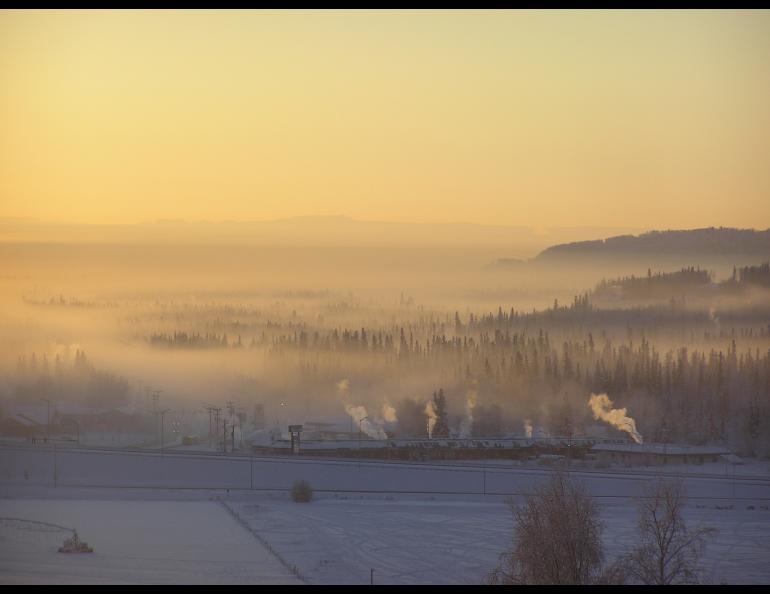Research underway at the University of Alaska Fairbanks Geophysical Institute and two other universities into Fairbanks wintertime air pollution aims to reveal what’s causing the previously unknown presence of a chemical compound known as hydroxymethanesulfonate in airborne fine particulate matter.
Results of the three-year research project, which is funded by the National Science Foundation, could become a consideration in how government regulators and elected officials choose to combat the region’s poor air quality.
Scientists discovered the compound in Fairbanks two years ago during an analysis of air samples as part of a larger air quality study.
That analysis revealed the presence of the hydroxymethanesulfonate as a component of the PM2.5 fine particulate matter — particles less than 2.5 micrometers — that often plagues Fairbanks during the winter months, said assistant professor Jingqiu Mao at the Geophysical Institute.
“Our goal for this National Science Foundation project is to understand how hydroxymethanesulfonate is formed and its fate during winter in Fairbanks,” Mao said. “We know that hydroxymethanesulfonate has two precursors — sulfur dioxide and formaldehyde.”
Sulfur dioxide reacts with formaldehyde to form hydroxymethanesulfonate in aerosols or droplets.
Sulfur dioxide, however, can also react with oxidants to form sulfate. That fact is important because the formation and properties of the sulfate and hydroxymethanesulfonate compounds differ widely.
The difference between the two compounds is also significant because a sizable fraction of what an EPA database had reported as sulfate in Fairbanks air pollution was actually hydroxymethanesulfonate, according to the research proposal.
That mischaracterization could, depending on the outcome of the research, have implications in how to reduce the area’s PM2.5 level by bringing attention to formaldehyde as a potential driver of PM2.5 pollution.
That’s what other researchers determined when studying the winter haze in Beijing, China, which was also found to have high levels of hydroxymethanesulfonate. A 2018 study published in Geophysical Research Letters found that a policy of reducing sulfur dioxide production by the “shutting of coal plants in the Beijing area and adoption of stricter SO2 emissions controls would be ineffective against severe haze” because it is formaldehyde, not sulfur dioxide, that is the driving force in the production of hydroxymethanesulfonate.
“Policymakers may need instead to focus on quantifying and reducing sources of HCHO [formaldehyde], such as from gasoline and diesel engines,” that 2018 study concluded.
A separate study of air quality in China, published in 2020 in the Journal of Geophysical Research, came to a similar conclusion about the importance of formaldehyde as a factor in wintertime haze.
“Controlling emissions of formaldehyde or emissions of the volatile organic compounds that can create formaldehyde in the atmosphere can therefore have the added co‐benefit of also reducing the levels of sulfur in particle air pollution,” it concluded.
Knowing how hydroxymethanesulfonate forms in Fairbanks is important, according to Mao and atmospheric chemistry professor Rodney Weber at the Georgia Institute of Technology. Both of its precursor chemicals — sulfur dioxide and formaldehyde — escape during the burning of wood and the combustion of fossil fuels.
The new research aims to find out where, and under what conditions, the sulfur dioxide and formaldehyde combine to form hydroxymethanesulfonate in Fairbanks.
The burning of wood for home heating has been found previously to account for the largest portion of fine particulate matter in Fairbanks’ bad winter air.
“If you want to suggest effective ways to control and lower PM2.5 mass, and since hydroxymethanesulfonate at times can be an important contribution to PM2.5 mass, one needs to know where it comes from,” Weber said.
The research involves investigating the sources of hydroxymethanesulfonate by measuring levels of formaldehyde, inorganic sulfate and hydroxymethanesulfonate itself.
“Even though we know the precursors of hydroxymethanesulfonate, we do not know what factors — temperature, relative humidity, wood smoke, etc. — can facilitate its formation,” Mao said.
The research will benefit communities beyond Fairbanks, said research assistant professor Jason St. Clair of University of Maryland Baltimore County.
“Fairbanks is a great place to study this chemistry because the low-light conditions of wintertime in high latitudes remove a normally important atmospheric chemistry variable: sunlight, which usually drives atmospheric oxidation,” he said. “What we learn here will help improve air quality not just in Fairbanks and Alaska but also in other high latitude cities facing similar air quality challenges.”
Fairbanks has struggled with poor wintertime air quality for several years and is under mandate by the federal Environmental Protection Agency to improve its air or face sanctions, which could include the imposition of severe mitigation efforts and potential fines for noncompliance.
Weber, an expert in aerosol measurements, wrote the grant proposal and is the lead principal investigator for the Fairbanks project. Mao is the lead UAF researcher on the project, and St. Clair is the lead for the University of Maryland, Baltimore County. St. Clair has, in conjunction with NASA Goddard Space Flight Center’s Atmospheric Chemistry and Dynamics branch, analyzed the presence of formaldehyde at various locations around the world.

